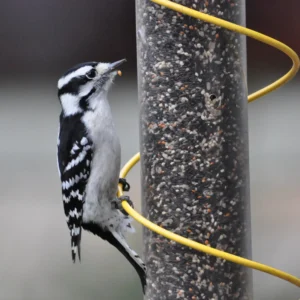Did you know that there are more than 300 species of woodpeckers throughout the world, with 23 species found within the United States and seven in Pennsylvania?
W oodpeckers are part of the larger family of birds known as Picidae that are found across the globe with the exception of Antarctica, Australia, New Zealand, Madagascar, and the more extreme regions in the arctic. Most species of woodpeckers can be found living in forested or woodland habitats, although a few are known to live in treeless areas with cacti. Woodpeckers’ fossil remains date back 25 million years to the Lower Miocene period.
Woodpeckers excavate trees to find food, to nest, and to communicate. They drill into trees to uncover insect food, such as wood-boring grubs, insects, insect eggs, and pupae found in dead and living trees. The bird’s tongue is exceptionally long and covered in sticky saliva cells with a pointed and barbed tip.
After pounding into the tree, the birds use their tongue to probe for insects that happen to be inside. They also consume sap from trees, nuts like acorns, and the fruits of trees and vines.

Downy Woodpecker
Woodpeckers also have special physical adaptations including short, muscular legs and sharply clawed feet. On most species, the first and fourth toes are paired facing backward and the second and third toes face forward. These ‘zygodactyl’ feet are excellent for clinging to and climbing trunks of trees.
Woodpeckers’ stiff tail feathers catch on the bark to brace the bird as it works on opening holes in trees and branches. During molt, the two middle tail feathers (the strongest ones) do not fall out until the other 10 have been replaced and can support the bird’s weight.
Courtship and nesting habits are essentially alike in all woodpeckers. After males and females pair, both sexes work together to excavate a nest cavity in a branch, tree trunk, or desert cactus. The female usually lays eggs directly on wood chips or vegetation left in the bottom of the cavity.
Depending on the species, the female can lay anywhere between 3-10 eggs. Both sexes incubate the eggs, with the more aggressive male often incubating the eggs overnight. Young are altricial, or hatch featherless and blind. As they develop into mature birds, they’ll remain in the nest for two to three weeks prior to fledging.






